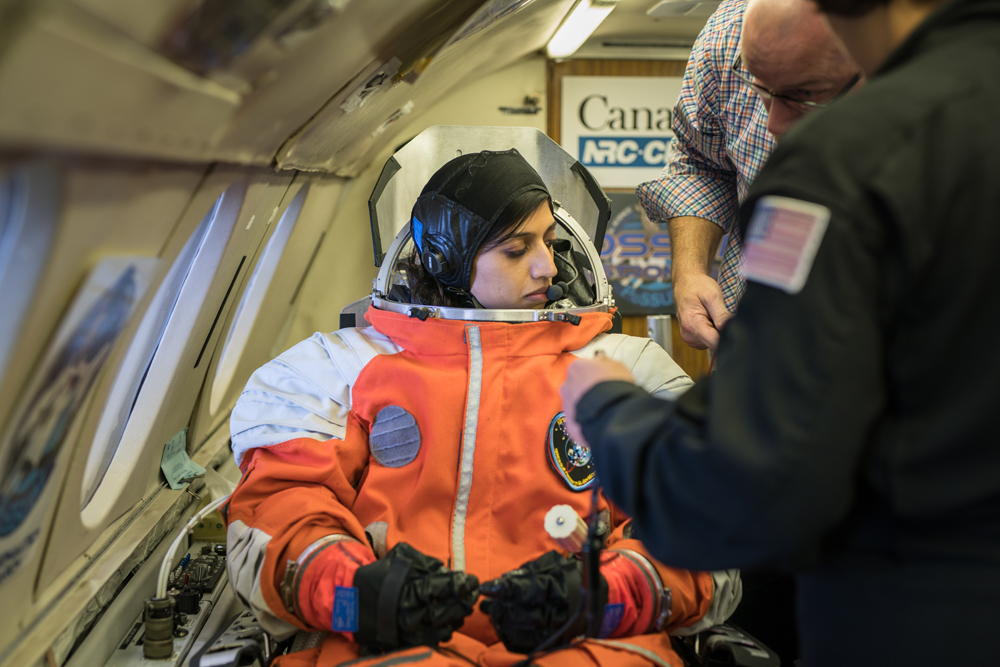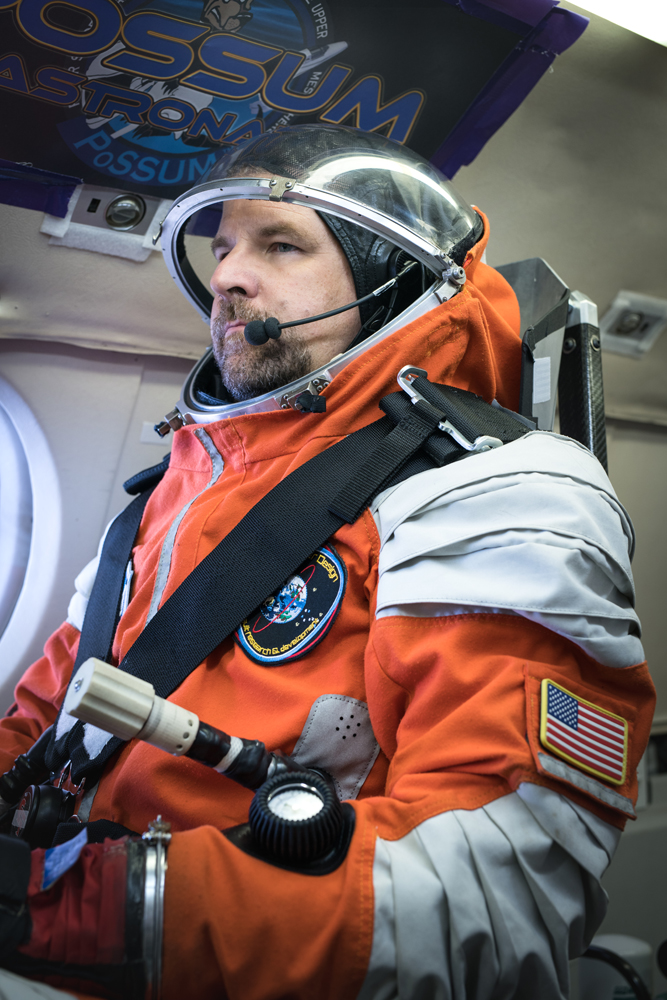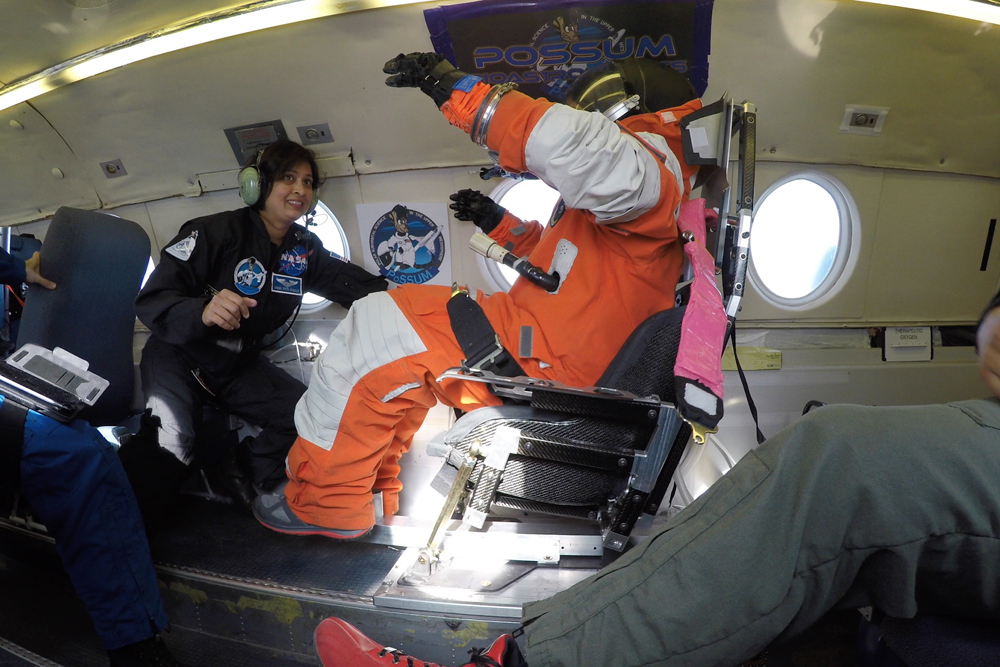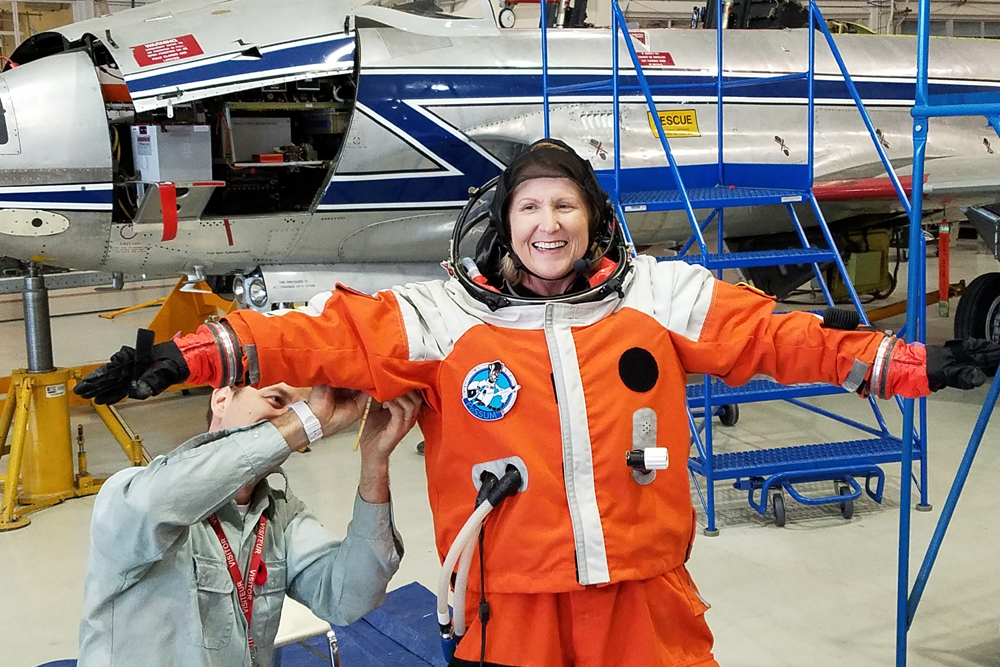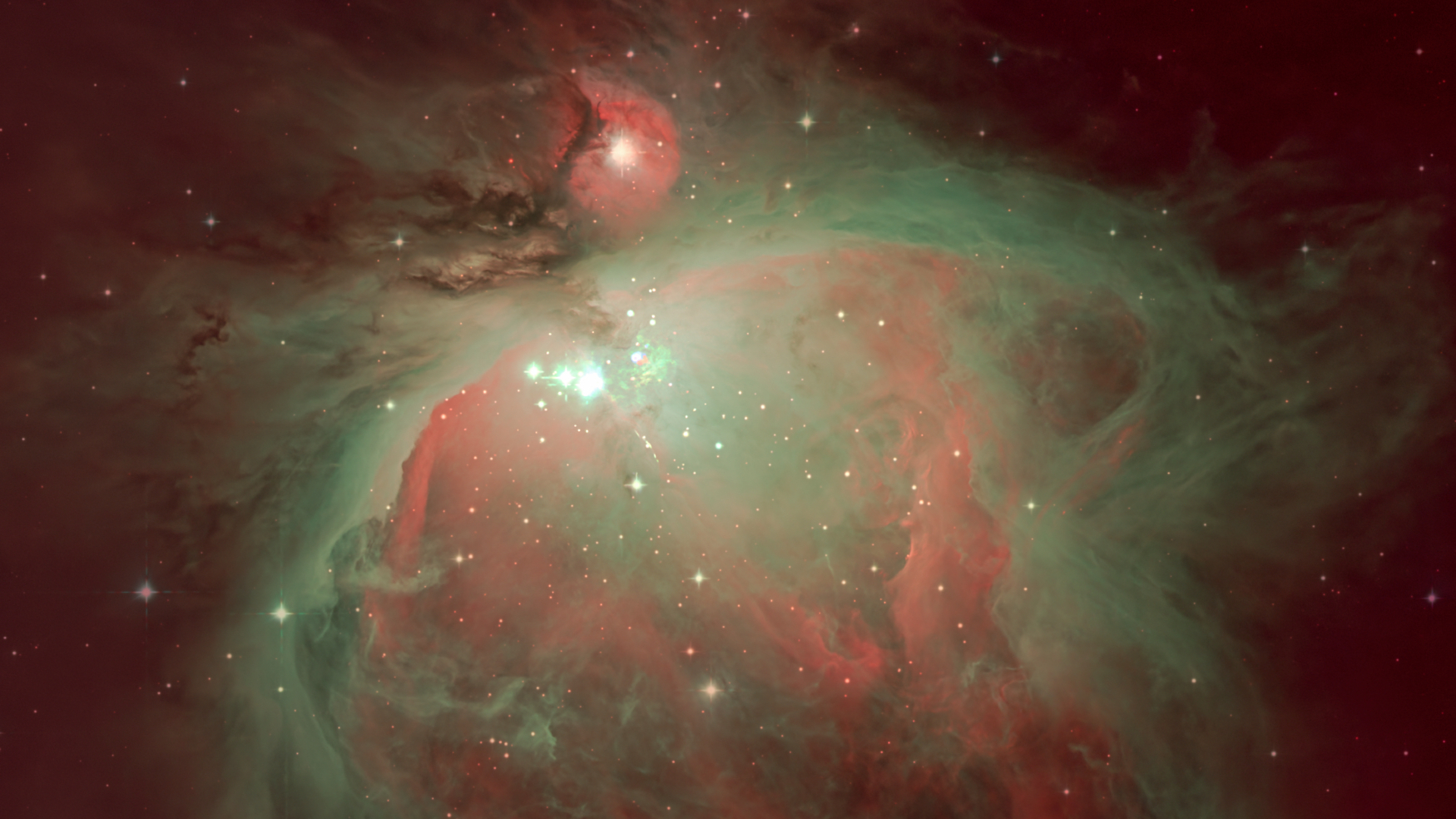Private Spacesuit Undergoes Zero-G Testing to Prepare for Commercial Flights
Next stop, space? A spacesuit from Final Frontier Design did its third round of Canadian flight testing last month in preparation for eventual space tourist flights.
Between Oct. 2 and 5, the company flew its 3G Intra-Vehicular Activity suit on three flights over Ottawa on Falcon 20 jets; each flight had 18 parabolas to simulate microgravity for a few seconds. For the first time, testing was "visor down" on the suit — meaning that the subjects were fully sealed inside.
It was an important challenge for Final Frontier to meet, co-founder Ted Southern told Space.com. During previous Canadian flights in 2015 and 2016, the suit's visor was up. [Final Frontier Design: A Private Spacesuit Experience in Photos]
"One of the biggest risks of microgravity is vomit. If you vomit inside a closed spacesuit in microgravity, there's a risk of inhalation and choking on your own vomit," Southern said. "It's a big step to go visor-down because of the risk involved, and also because you're relying on a life support system to sustain someone."
Each spacesuit subject was tested for vital signs such as blood oxygen, carbon dioxide, heart rate and body core temperature. Participants also had to operate a control system with a joystick and monitor while fully suited up.
Riding along with Final Frontier were two partners who have their own interests in spacesuit research. One of them is Project PoSSUM (Polar Suborbital Science in the Upper Mesosphere), which eventually wants to use suited-up scientists to study clouds in the mesosphere. The other was the hosting organization, Canada's National Research Council, which wants to better understand why astronauts get sick in space.
Planning for commercial spaceflight
Southern and his Final Frontier co-founder, Nikolay Moiseev, first met each other as competitors during a NASA challenge intended to make better spacesuit gloves. In a subsequent 2009 competition, they paired up and won second prize ($100,000) in NASA's glove challenge.
Breaking space news, the latest updates on rocket launches, skywatching events and more!
The two founded Final Frontier Design — based in the Brooklyn Navy Yard — and have been busy with spacesuit research ever since. They now have seven spacesuits under their belt, encompassing four generations of changes. Their funding includes four Small Business Innovation Research grants, a NASA Space Act Agreement, a NASA fixed-price contract and a Flight Opportunities Program grant for microgravity testing.[Evolution of the Spacesuit in Pictures (Space Tech Gallery)]
While they're busy creating spacesuits, Southern says NASA won't have a place for those suits in the upcoming Orion space program. (NASA instead is going with a variation of the space shuttle's Advanced Crew Escape Suit for interior activities.) But down the road, Southern said he could see partnerships with entities such as Zero 2 Infinity, a Spanish ballooning company, or Starfighters Aerospace, a Kennedy Space Center company that operates F-104 supersonic aircraft for science and commercial work.
Southern worries about the many commercial companies — Virgin Galactic, Blue Origin, World View — that plan to bring private citizens into space without pressurized suits.
"I think that's crazy," Southern said, pointing out that NASA and other space agencies have astronauts wear suits during launch and landing. (The unsuited Russian Soyuz 11 crew was killed in 1968 due to spacecraft depressurization during landing.) "Suits have proven to be useful … they are just like the oxygen masks that fall down from a commercial airliner when you're at 35,000 feet."
Southern said there would be more microgravity spacesuit testing in the coming weeks. He's also hoping to do a fourth round of Canadian testing with the National Research Council next year. [No Bathrooms, No Barf Bags: What Blue Origin's Space Tourists Can Expect]
Clouds and climate change
Final Frontier and the nonprofit PoSSUM have been working together for about five years. PoSSUM's eventual goal is to do high-resolution imaging of noctilucent clouds, which form in the upper atmosphere and could be an indicator of climate change, according to the group's executive director, Jason Reimuller.
The clouds form in the mesosphere, in a zone that is too high for high-altitude balloons to reach, and too low for spacecraft.
It's a zone that thus would be perfect for scientists in commercial spacecraft, Reimuller told Space.com in a separate interview. Reimuller studied these clouds as part of his dissertation research. To get a better look at the clouds, the scientists would need to be suited up while studying them from commercial spacecraft. This prompted the partnership with Final Frontier, to learn how to design instruments capable of being manipulated in a spacesuit.
Future flights, Reimuller said, could "fly through a cloud and focus on small structures we know exist that haven't been seen before. In doing so, we could really improve the models and our understanding of the upper atmosphere. This has direct implications for the man-made drivers of climate change, [including] designing hypersonic vehicles or vehicles that will operate in that region of our atmosphere. It also helps us understand low-density atmospheres, like on Mars."
But in the near future, Reimuller looks forward to a lot more instrument testing, including balloon flights in Antarctica (in December) and northern Canada (next summer) to study the clouds as best as possible from a lower altitude.
Space sickness
Humans have flown in space for nearly 60 years, and many of them experienced space sickness — which is also called space adaptation syndrome. According to a 2009 article in Air&Space magazine, the problem gained prominence at NASA during the Apollo program, when astronauts had room to move around in their spacecraft.
The problem persisted through Skylab and the space shuttle program, and likely still affects astronauts today on the International Space Station, although it isn't often discussed. Veteran flyers are advised to keep their heads still in the first few days in orbit, or to take antihistamines such as promethizine (Phenergan) and scopalamine, the article added.
The NRC has conducted research into space sickness for several decades, but there's a gap in this research overall, said Derek Gowanlock, the facility manager for the Falcon 20 that did the spacesuit parabolic flights. Specifically, there isn't much information available about motion sickness in microgravity.
"A lot of motion sickness research is based on dynamic maneuvering, whether it's aerobatic flight fighter jet type of stuff, or simulated … [devices in which] you can spin the person in three dimensions. Microgravity datasets are quite limited. There is data, absolutely, but it's nationally controlled. The NASA space program gathers data, but it's not widely published for research purposes."
Gowanlock said all participants in the Falcon 20 flights were monitored for warning signs of motion sickness, with the aim of eventually providing good antidotes. The motion sickness pills and patches that participants use today are only partially effective, he added.
"One of the applications of this research and knowledge development would be commercial space providers such as Virgin Galactic and Blue Origin," he said. These providers are planning short microgravity flights for paying tourists, he added, and the goal is to prevent space sickness in these situations.
Follow us @Spacedotcom, Facebook and Google+. Original article on Space.com.

Elizabeth Howell (she/her), Ph.D., was a staff writer in the spaceflight channel between 2022 and 2024 specializing in Canadian space news. She was contributing writer for Space.com for 10 years from 2012 to 2024. Elizabeth's reporting includes multiple exclusives with the White House, leading world coverage about a lost-and-found space tomato on the International Space Station, witnessing five human spaceflight launches on two continents, flying parabolic, working inside a spacesuit, and participating in a simulated Mars mission. Her latest book, "Why Am I Taller?" (ECW Press, 2022) is co-written with astronaut Dave Williams.
